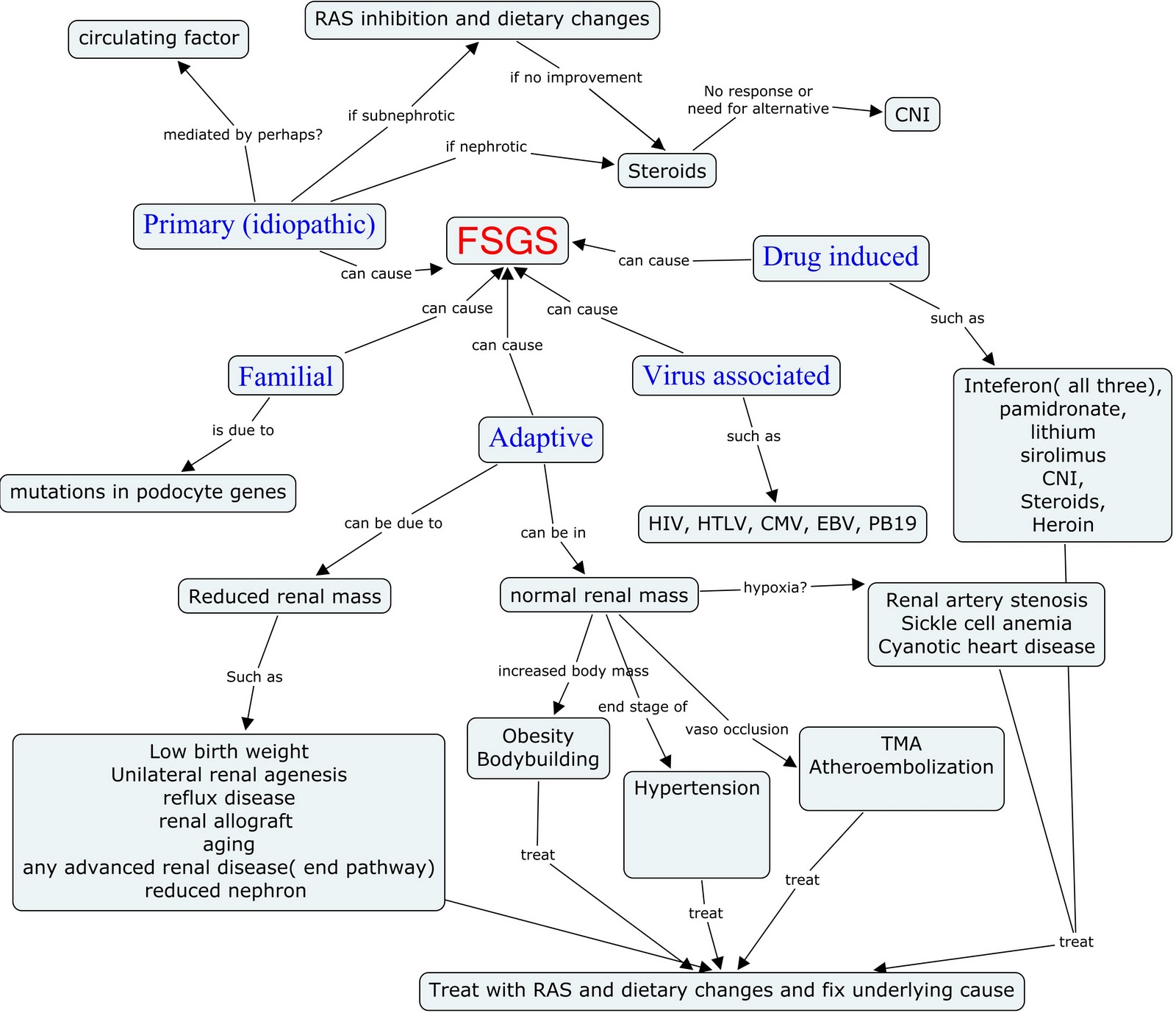Focal segmental glomerulo sclerosis

"Focal" means that some of the glomeruli become scarred. Others remain normal. "Segmental" means that only part of an individual glomerulus is damaged.
Causes
The cause of focal segmental glomerulosclerosis is often unknown.
The condition affects both children and adults. It occurs slightly more often in men and boys. It is also more common in African Americans. Focal segmental glomerulosclerosis causes up to a quarter of all cases of nephrotic syndrome.
Known causes include:
- Drugs such as heroin, bisphosphonates, anabolic steroids
- Infection
- Inherited genetic problems
- Obesity
- Reflux nephropathy (a condition in which urine flows backward from the bladder to the kidney)
- Sickle cell disease
- Some medicines
Symptoms
Symptoms may include:
- Foamy urine (from excess protein in the urine)
- Poor appetite
- Swelling, called generalized edema, from fluids held in the body
- Weight gain
Exams and Tests
The health care provider will perform a physical exam. This exam may show tissue swelling (edema) and high blood pressure. Signs of kidney (renal) failure and excess fluid may develop as the condition gets worse.
Conventional tests: urine test, blood test, and kidney biopsy.
• Immune special examination and diagnosis
- Kidney damage tests. Checking items include: UTP, U-malb, U-TRF, U-IGG, β 2-microglobulin, α1-microglobulin, α2-macroglobulin, κ light chain, λ light chain, U- NAG, U-GGT, and Uosm.
- Urinary protein electrophoresis.
- Selective urine protein index (SPI).
- Complement in blood serum test. This test include C3, C4, CH50, C3B, etc.
- Toxins in blood test. Checking items include: BUN, Creatinine, UA, β 2-microglobulin, Cyc C, RBP, HCY, and PTH.
Outlook
Over 50% of people with this disease develop into Chronic Kidney Failure within 10 years. Fortunately, timely and effective treatment can help patients prevent renal failure. For information about the best treatment for you, feel free to Contact Us.
Kidney Transplant in FSGS
The risk of this disease returning in the transplanted kidney varies from 20-50%. The recurrence can happen within hours to days, though most cases will be within the first year after transplant.
More than half of patients with recurrent FSGS in their transplant will lost their kidney within 5 years. Hence, once the disease comes back to the new kidney, it is essential to get timely treatment and avoid transplanted kidney failure. Blood Pullotion Therapy is recommended.
Tests may also include:
- Kidney biopsy
- Kidney function tests (blood and urine)
- Urinalysis
- Urine microscopy
- Urine protein
Treatment
Treatments may include:
- Medicines to reduce the body's inflammatory response.
- Medicines to lower blood pressure. Some of these medicines also help reduce the amount of protein that spills into the urine.
- Medicines to get rid of excess fluid (diuretic or "water pill")
- Low sodium diet to reduce swelling and lower blood pressure
The goal of treatment is to control the symptoms of nephrotic syndrome and prevent chronic kidney failure. These treatments may include:
- Antibiotics to control infections
- Fluid restriction
- Low-fat diet
- Low- or moderate-protein diet
- Vitamin D supplements
- Dialysis
- Kidney transplant
Outlook (Prognosis)
More than half of those with focal or segmental glomerulosclerosis develop chronic kidney failure within 10 years.
Possible Complications
Complications may include:
- Chronic kidney failure
- End-stage kidney disease
- Infection
- Malnutrition
- Nephrotic syndrome
When to Contact a Medical Professional
Call your provider if you develop symptoms of this condition, especially if there is:
